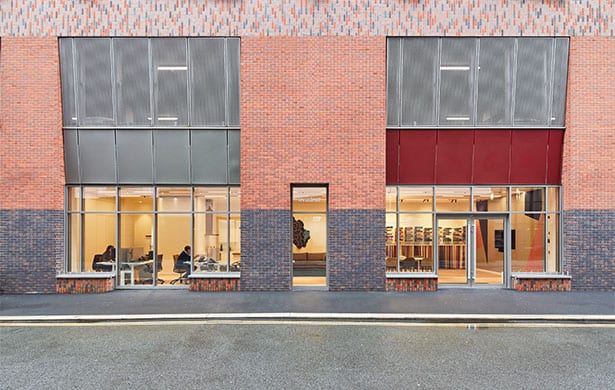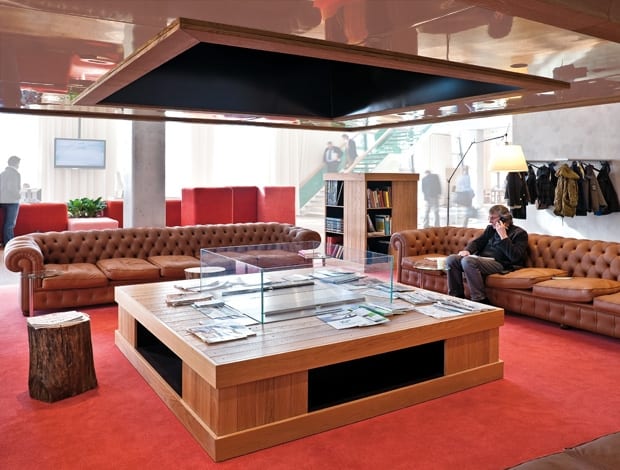 |||
|||
There’s something delightful about the story of Loops. Perhaps it is the functionality and playfulness of a chair that “stretches” into a bench, or the seemingly organic evolution of a craft-made object into a manufactured product, but I have a feeling a lot of it has to do with the wonderfully collaborative effort of designer Studiomama and manufacturer MARK Product.
What could be described as a series of fortunate events for Studiomama founder Nina Tolstrup, and husband and design collaborator Jack Mama, began as an upcycling project. Aptly named Re-imagined, the chair was born after Tolstrup came across a set of “unloved [office] chairs” she brought to the workshop, where they were stripped down to their bare frames, remodelled, rewelded and finished in different colours. “The departure point was exploring different sustainable ways of working,” she says. “Upcycling is one way.”
 Early designs for Re-imagined stripped existing chairs back to their bare frames
Early designs for Re-imagined stripped existing chairs back to their bare frames
Nominated for Design of the Year by the Design Museum in 2013, the Re-imagined chair was shown in London’s 19 Greek Street Gallery as well as Milan, with collaborations with Marc Jacobs and David David seeing the chair reupholstered in, respectively, bold checks and geometric patterns.
“These things,” Tolstrup says, “you do out of playfulness, without any consideration for customers and no market in mind. They are one-offs.” This changed when, in March 2017, Studiomama got a request from restaurateur and chef Fred Peneau for the Mandrake Hotel’s new restaurant. All of a sudden, these one-offs had to be produced at a larger scale, and with an end-user in mind. That is where MARK Product entered the picture, by introduction of Brian Greathead – founder of Manalo & Whites, the architect behind this project. In retrospect, this was a pivotal moment in the early history of Loops. But let’s not get ahead of ourselves.
 A concept sketch for Re-imagines explores the shapes later echoed in the Loops designs
A concept sketch for Re-imagines explores the shapes later echoed in the Loops designs
“We’ve always wanted to work with MARK Product,” says Mama, a sentiment echoed by Tolstrup, who argues the local production was “a great match” for the studio. Indeed, MARK Product is based in Cornwall, where it manufactures all of its furniture. “Producing locally is ticking one box of the sustainable way of producing,” Tolstrup says, true to her Scandinavian-led integrity. As for MARK Product founders John Miller and Anna Hart, this was the first collaboration of this kind: “It disrupted our thoughts,” says Hart, further encapsulating the essence of Re-imagined: “So often, the furniture comes after the building, whereas this was an integral part of making that restaurant, which is very unique.”
Fast-forward a few months, the restaurant is dotted with velvet Re-imagined chairs dressed in Kvadrat Harald, and the two teams want to continue working together. Enter phase two: adapting the chairs to the contract furniture market, thus moving away from Re-imagined to enter Loops territory.
 Re-imagined chairs were remodelled then finished in a variety of colours
Re-imagined chairs were remodelled then finished in a variety of colours
-imagined was a project; Loops is a product,” explains Miller, and the transition is evident. From its function, through the size and scale, all the way to its materiality, Loops is a brand new product that bears only the concept and oval shape of its predecessor. The team explains the necessity for this remodelling had a lot to do with the Loops mission: a chair that is no longer destined to grace the podium of a gallery but instead be in an office where it would gain functionality. As Miller explains: “There’s a while to go from a craft-made object to something which is a manufactured product. The techniques and materials you’d use are different. In the first collection, there was a much higher degree of hand-finishing and hand-stitching on the back.”
Still, Loops has a crisp yet inviting Scandi feel to it (Tolstrup’s Danish roots must’ve played a part), and despite the move away from craft-made, the attention to detail remains evident. MARK Product did away with all visible fixings (even the bottoms are finished to perfection) and adapted the size and materiality for the office market. The size increased by 10% and Kvadrat Harald was replaced by several shades of Kvadrat Canvas.
 Manufacturing Re-imagined for the Mandrake Hotel meant rethinking the product to suit an end-user
Manufacturing Re-imagined for the Mandrake Hotel meant rethinking the product to suit an end-user
Today, the sit and feel of the Loops chair reflect a certain balance. To borrow Miller’s words: it is “comfortable without being opulent”. It looks as playful as it looks utilitarian. “From a specifying point of view, it’s got to be integrated with the way it’s being used,” says Hart, who envisions the Loops collection sitting in a space where “people want to go and think differently”.
And although Loops is intended for the workplace, the collection itself can be subdivided into “dining height” and “lounge furniture”, further emphasising MARK Product’s perception of the blurred boundaries between hospitality and workplace.
 After experimenting with fabric colours they opted for Kvadrat’s Harald velvet
After experimenting with fabric colours they opted for Kvadrat’s Harald velvet
“It started with the chair,” says Miller. “From a manufacturing point of view, there’s a drive to have as many common parts as possible.” Then came Loops sofa and bench, followed by tables, the height of which seems very much dictated by function and the way people work.
“The tables came easily,” Mama says. “What’s nice is to see the interplay between them.”
As for the name Loops – “Naming products is really important, and really hard,” explains Miller. “Loops references the shape, and it’s another word for reimagining. We’ve gone beyond reimagining. We’re now in a loop.”
In the first of a new series we take apart the process that led to the creation of Studiomama and MARK Product’s Loops collection































